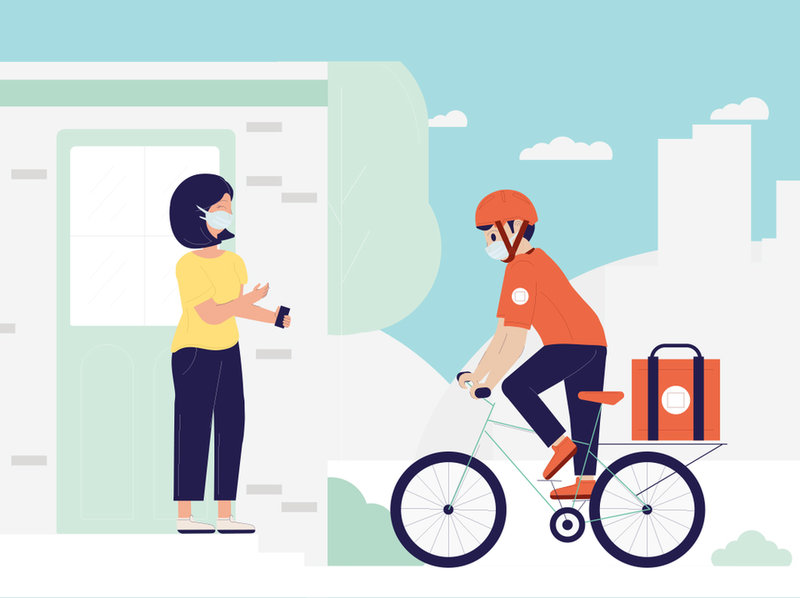CORONAVIRUS | CASE STUDY
Uber Eats: thriving in the pandemic and beyond
Uber’s ridesharing business may have seriously stalled during the coronavirus pandemic, but its delivery arm, Uber Eats, has thrived. Lucy Ingham hears from VP Pierre-Dimitri Gore-Coty about how the company has managed and responded to this growth.
When Pierre-Dimitri Gore-Coty took on the role of VP of Uber Eats, it was meant to be a step up in his eight-year career at Uber that would see him slowly bring his vision to the ridesharing giant’s secondary business.
But then the pandemic happened, and suddenly he found himself at the helm of a core revenue generator for one of the world’s biggest startups.
“I literally transitioned to Uber Eats about three months ago, which is pretty much when the Covid crisis started to really kick in across many of our countries around the world,” he says, speaking at the technology conference Collision at Home.
Food delivery a silver lining during the pandemic
The impact of the pandemic on Uber has been significant. The company reported its biggest loss in three quarters, losing $2.9bn during the outbreak as its ridesharing business saw user numbers plummet. The company was forced to lay off 3,700 full-time employees – 14% of its workforce – and while the company is optimistic that it will regain these lost numbers, CEO Dara Khosrowshahi warned investors that the impact had been “dramatic”.
However, there was a silver lining for Uber, in the form of its Eats business. The food delivery service saw bookings climb 54% year-over-year, as those in lockdown looked to deliveries both to treat themselves and access groceries.
It also attracted a swathe of new restaurants and other outlets, which turned to delivery as an alternative means of keeping their businesses going during the lockdown.

Pierre-Dimitri Gore-Coty, VP, Uber Eats, Image: Uber Eats
In short, Eats has been a shining success for Uber amid otherwise challenging times, but for Gore-Coty it has been something of a baptism of fire. “The past few months have definitely been very intense, and have forced us to rethink a lot of how we do business,” he says.
Amid the pandemic, the essential Uber Eats model has not changed. Users order food from a choice of outlets through the app, which is prepared, collected by an Uber Eats driver and delivered soon after. However, the company has made adjustments, many of which have been designed to improve safety for all involved.
“We've tweaked our app such that we could include, very early on, some notifications and some safety messaging, not just for the courier, the delivery people, the consumers, but also for the restaurants,” says Gore-Coty. “The safety theme has been a very important point for us throughout the crisis.”
As part of this, there have also been adjustments to the delivery process, to ensure the company “can operate in this new world”.
“That means rolling out pretty quickly things like contactless deliveries, which today 60% of consumers are actually choosing, allowing them to get their food without having to interact with a courier,” he explains.
The safety theme has been a very important point for us throughout the crisis.
However, the company also sought to tackle the economic damage wrought by the pandemic, particularly by the hospitality industry, which has seen unprecedented contraction as restaurants, bars and cafes were forced to close.
Gore-Coty highlights that “trying to support the restaurant community” has been a key priority for Uber Eats during the pandemic, saying that “we did our best to drive more demand to them”.
“We cut fees on some of those small restaurant SMBs so that more eaters could use those restaurants; we included in-app donations – about $10m was raised through those in-app donations that go directly to restaurants – and we've helped encourage new use cases like the pickup use case, for instance, to try and make it easier for restaurants,” he says.
The company has also, according to Gore-Coty, sought to provide additional support to drivers, “making sure in many countries around the world that we could actually provide some sort of financial safety net throughout the crisis for some of them that were maybe hurt by the disease”.
This has included making it easy for Uber drivers, who have seen a severe drop-off in work, to switch to the Eats arm of the business, “to make sure that they could continue to earn”.
“A lot of drivers actually became delivery people, and in the US up to 40% of the drivers have actually moved to the delivery side.”
Expanding to groceries and beyond
As part of its pandemic response, Uber Eats has also increased the prevalence of its grocery deliveries, in part by building partnerships with outlets whose own offerings in this space are weaker than some of their competitors.
This was largely in response to the challenges faced by consumers in securing delivery slots for online supermarkets, which created sudden, urgent demand for additional means to get groceries delivered.
“The way we think about business is really one mobility unit, which is helping you get from A to B, and then we have a delivery business unit which is really around on you to get things delivered to you,” says Gore-Coty.
“We have primarily focused so far on restaurant food as a primary vertical, and we are expanding towards new use cases, grocery being one of them, and hopefully more services and products down the line.”

However, this move into groceries is not so much a sharp pivot in response to the pandemic, but an acceleration of plans it has been working on for some time, particularly through the acquisition of Chilean grocery delivery startup Cornershop, which was first announced in October 2019, and is currently in review.
“We have acquired a company called Cornershop, we are in the process of getting this transaction closed; it is subject to antitrust review,” he says. “And we received some very promising news at the end of May in terms of the competitive authority approving that deal.”
Notably, the company does not plan to stop at groceries. In the longer term, it wants to expand its delivery capabilities beyond the food segment entirely, through Uber Direct. This launched amid the pandemic in some segments such as South Africa, in recognition that the increase in delivery demands extended across the entire spectrum of ecommerce.
“This Uber Direct offering is really making our delivery services available to third parties for them to deliver and ship whichever objects they want,” he says. “So I'd say this is really something that is still early days, but we're trying to push.”
However, while this segment shows promise, Gore-Coty stresses that its core focus for now remains in the food space.
“It's a bit early to tell what we'll see what the future is made of, and we think that right now on our hands, with grocery and restaurant food, we have actually a pretty enormous category for us to tap into. We feel a lot of growth ahead of us, and I'd say that's our primary focus at this point.”
Towards profitability
Despite the impressive growth that Uber Eats has achieved during the pandemic, it is afflicted by the same issue as its parent company: profitability.
While Uber Eats has achieved substantial revenue increases during the outbreak, it has also faced an increase in losses, echoing the concerns that dog the wider Uber business about when – if ever – it will be profitable. However, Gore-Coty is positive about the signs.
“What we've seen throughout the Covid phase, so pretty much since I started on Uber Eats, we've seen a rapid acceleration of our growth on the back of very strong consumer demand,” he says.
“As far as profitability is concerned, that guidance that we have shared publicly, is that the Q2 EBITDA [earnings before interest, taxes, depreciation and amortisation] loss for Uber Eats will be broadly in line what we did in Q1.
The company has very much been geared towards growth at all costs.
“And if you think about the strong increase we've seen in the top line, that is actually translating into some strong margin improvements sequentially from Q1 to Q2. So I'd say we feel quite good actually, about our trajectory so far.”
Despite the positive feelings, Gore-Coty does admit that profitability is an “important part” of his job, and that the next few years will see a greater focus on making it a reality.
“The company has very much been geared towards growth at all costs. And it has done a pretty good job at that when you think about what Uber has built in the food delivery space in a matter of four years, he says.
“But it's time now to move from growth at all costs to sustainable growth, frankly, and to be able to demonstrate the ability for each to become a profitable business. So that's certainly one of my one of my big focus areas, there's no doubt about that.”